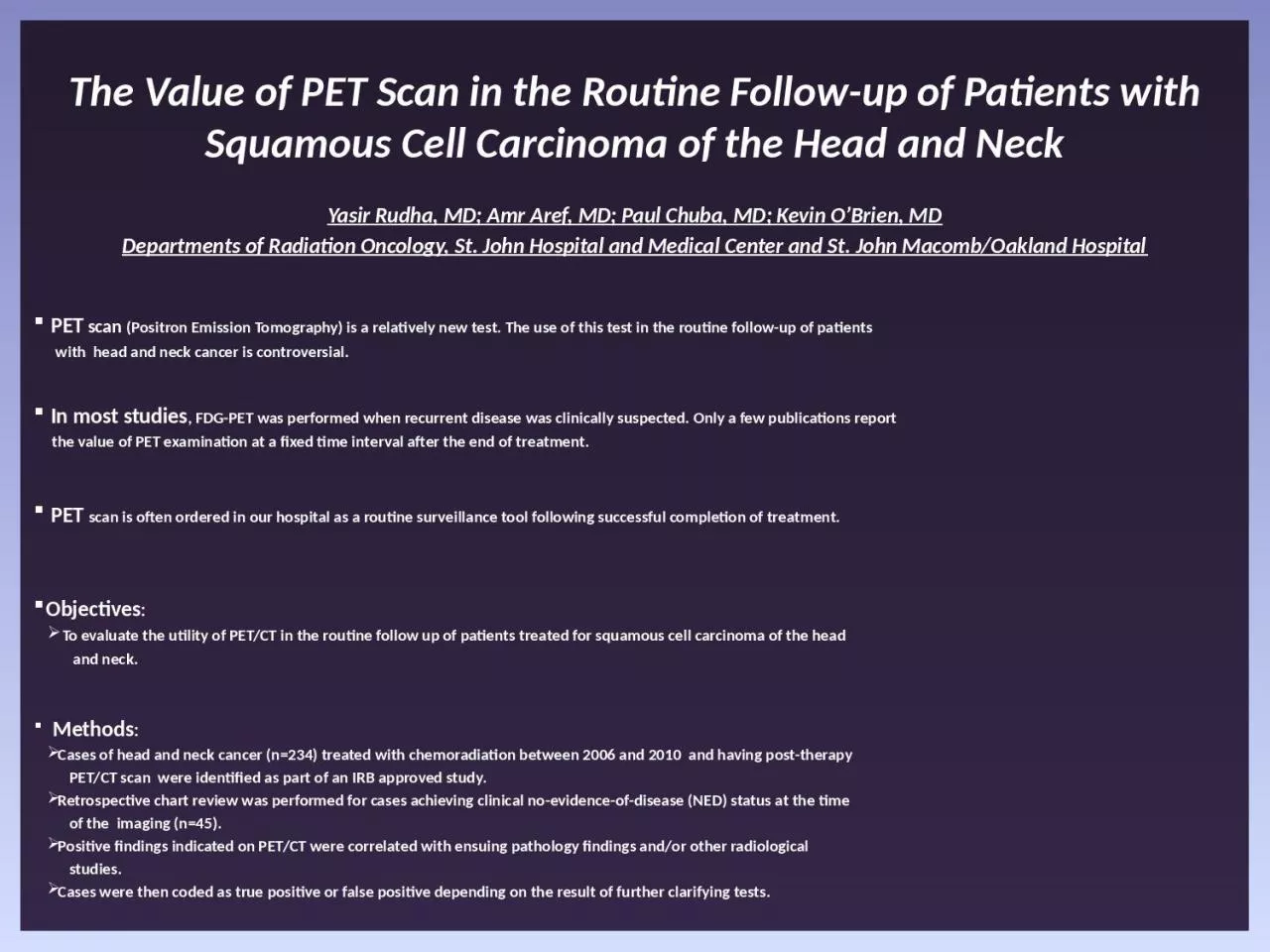

Squamous Cell Carcinoma of the Head and Neck Yasir Rudha MD Amr Aref MD Paul Chuba MD Kevin OBrien MD Departments of Radiation Oncology St John Hospital and Medical Center and St John MacombOakland Hospital ID: 921045
Download Presentation The PPT/PDF document "The Value of PET Scan in the Routine Fol..." is the property of its rightful owner. Permission is granted to download and print the materials on this web site for personal, non-commercial use only, and to display it on your personal computer provided you do not modify the materials and that you retain all copyright notices contained in the materials. By downloading content from our website, you accept the terms of this agreement.
Slide1
The Value of PET Scan in the Routine Follow-up of Patients with
Squamous
Cell Carcinoma of the Head and Neck
Yasir
Rudha
, MD;
Amr
Aref
, MD; Paul
Chuba
, MD; Kevin O’Brien, MD
Departments of Radiation Oncology, St. John Hospital and Medical Center and St. John Macomb/Oakland Hospital
PET
scan
(Positron Emission Tomography) is a relatively new test. The use of this test in the routine follow-up of patients
with head and neck cancer is controversial
.
In most studies
, FDG-PET was performed when recurrent disease was clinically suspected. Only a few publications report
the value of PET examination at a fixed time interval after the end of treatment.
PET
scan is often ordered in our hospital as a routine surveillance tool following successful completion of treatment.
Objectives
:
To evaluate the utility of PET/CT in the routine follow up of patients treated for
squamous
cell carcinoma of the head
and neck
.
Methods
:
Cases of head and neck cancer (n=234) treated with
chemoradiation
between 2006 and 2010 and having post-therapy
PET/CT scan were identified as part of an IRB approved study.
Retrospective chart review was performed for cases achieving clinical no-evidence-of-disease (NED) status at the time
of the imaging (n=45).
Positive findings indicated on PET/CT were correlated with ensuing pathology findings and/or other radiological
studies.
Cases were then coded as true positive or false positive depending on the result of further clarifying tests.
Slide2Results
Post-therapy PET/CT identified 15 patients with abnormality requiring further evaluation.
Of these, eight cases (53%) were proven to have malignancy based on biopsy findings.
Six out of 8 cases showed occult persistent disease at the primary site.One additional case was diagnosed with regional lymph node recurrence.And in one case a colon cancer was identified.All patients who had negative PET/CT scan remained free from local-regional relapse at the time of last follow up.In the remaining seven cases, imaging findings were shown to represent false positive results with unnecessary work-up and/or biopsy evaluation. Hence for this population the true positive rate for routine PET/CT surveillance in head and neck cancer patients is estimated as 8/15 = 53% and the false positive rate as 7/15 = 46%. Patient with Squamous Cell Carcinoma of Head and Neck Treatment NED in 1st Follow-up visit Routine PET/CT scan Results 66% No effect on the plan of management 34% Affect the plan of management 53.3% True Positive 46.7% False Positive
Slide3Conclusions
The routine use of PET/CT scan in the follow up of patients with
squamous
cell carcinoma of the head and neck may be useful for the detection of local-regional recurrences before they become clinically apparent. This in turn may improve the outcome of salvage therapy. The routine use of PET scan however is associated with a high false positive rate. This should be considered when ordering radiological exams and biopsies. A negative post therapy PET scan appears to be an excellent predictor of freedom from future loco-regional recurrence This study can impact the care of patients as :This result provides a further support for the routine use of PET scan as a surveillance method following treatment of head and neck cancer patient.